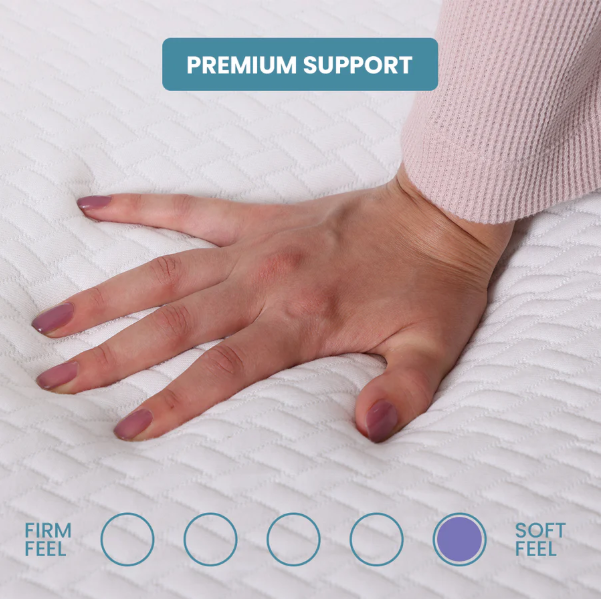The Science Behind Choosing the Right Mattress Topper for Back Pain

Poor sleep surfaces create a domino effect of spinal misalignment that transforms minor discomfort into chronic pain. Many people unknowingly worsen their back problems by sleeping on surfaces that fail to support their natural spinal curves. The relationship between sleep surface quality and back health runs deeper than most realise.
Research shows that the right mattress topper for back pain can address spinal alignment issues without replacing an entire mattress system. Sleep specialists consistently recommend specific topper materials and thickness levels based on individual body weight, sleeping position, and existing pain patterns. The science behind this recommendation centers on pressure point distribution and maintaining natural spine curvature throughout sleep cycles.
Understanding Mattress Topper Mechanics
Firmness Levels and Spinal Support: Different firmness levels affect spinal alignment in measurable ways. Medium-firm toppers typically provide optimal support for most back pain sufferers by preventing excessive sinking around the hips and shoulders. Softer materials can worsen pain by allowing the spine to curve unnaturally, creating pressure on nerve pathways and muscle groups.
The thickness of a topper directly impacts its ability to redistribute body weight effectively. Toppers between 2-4 inches offer the sweet spot for most users, providing enough material to cushion pressure points without compromising underlying mattress support. Thinner options often fail to address existing mattress deficiencies, perhaps explaining why many people see minimal improvement with budget alternatives.
Material Science Behind Pain Relief
Memory Foam Properties: Memory foam responds to body heat and pressure, creating custom contours around individual body shapes. This material reduces pressure points by up to 50% compared to traditional spring surfaces, according to sleep research studies. The viscoelastic properties allow the foam to compress under pressure while maintaining supportive resistance.
Temperature sensitivity in memory foam affects its pain-relieving properties significantly. Higher-density foams retain more heat, which some users find uncomfortable but others appreciate for muscle relaxation. Lower-density options provide cooler sleep but may compress too quickly for heavier individuals, reducing long-term support effectiveness.
Alternative Materials: Latex toppers offer different benefits for back pain sufferers. Natural latex provides responsive support that adjusts quickly to movement, making it ideal for combination sleepers who change positions frequently. The material maintains consistent support across temperature ranges, avoiding the softening that occurs with memory foam.
Gel-infused toppers attempt to combine pressure relief with temperature regulation. The cooling properties help users who experience heat retention with traditional memory foam. Research suggests gel infusions can reduce surface temperature by 2-3 degrees, improving sleep quality for temperature-sensitive individuals.
Body Type Considerations
Weight Distribution Factors: Heavier individuals require different topper specifications than lighter sleepers. Body weight affects how deeply someone sinks into a topper, changing the spine alignment dynamics completely. Sleep specialists recommend firmer, thicker toppers for individuals over 200 pounds to prevent excessive sinking that creates back pain.
Side sleepers need different support patterns compared to back or stomach sleepers. The natural curves of the spine change depending on sleep position, requiring toppers that accommodate these variations. Side sleeping creates more pressure on hips and shoulders, demanding softer surface areas in these regions with firmer support for the waist.
Pain Pattern Analysis
Identifying Root Causes: Different types of back pain respond to different topper characteristics. Lower back pain often stems from inadequate lumbar support, requiring firmer materials that maintain the spine’s natural S-curve. Upper back pain might indicate excessive pressure on shoulder blades, suggesting the need for softer, more contouring materials.
Morning stiffness patterns provide valuable clues about topper effectiveness. Pain that improves throughout the day typically indicates poor sleep surface support. Conversely, pain that worsens during the day might suggest other factors beyond sleep surface quality, requiring medical evaluation alongside topper selection.
Professional Recommendations
Sleep specialists emphasise the importance of trial periods when selecting toppers for back pain relief. Individual responses to materials vary significantly, making personal testing more valuable than general recommendations. Many companies offer 90-day trial periods specifically because body adaptation to new sleep surfaces takes several weeks.
Key factors sleep experts consider include:
- Body weight and sleeping position combinations for optimal support levels.
- Existing mattress condition and how it interacts with topper materials.
- Temperature preferences and how they affect material choice and pain relief.
- Movement patterns during sleep and responsiveness requirements for partner disturbance.
Long-term Effectiveness
Durability and Pain Management: Quality toppers maintain their supportive properties for 3-5 years with proper care, providing consistent pain relief over time. Cheaper alternatives often lose their supportive qualities within months, creating a cycle of temporary relief followed by pain recurrence. The initial investment in quality materials typically proves more cost-effective than repeated replacements.
Regular rotation and cleaning extend topper lifespan and maintain hygiene standards that support healthy sleep. Dust mites and allergens can accumulate in sleep surfaces, potentially contributing to sleep disruption and indirect pain issues through poor sleep quality.
Conclusion
Understanding the science behind topper selection empowers individuals to make informed decisions about their sleep health and pain management strategies. The relationship between spinal alignment, pressure point relief, and material properties creates a complex but solvable equation for back pain sufferers. Take action today by evaluating your current sleep surface and considering how the right topper could transform your nights into restorative, pain-free experiences.




